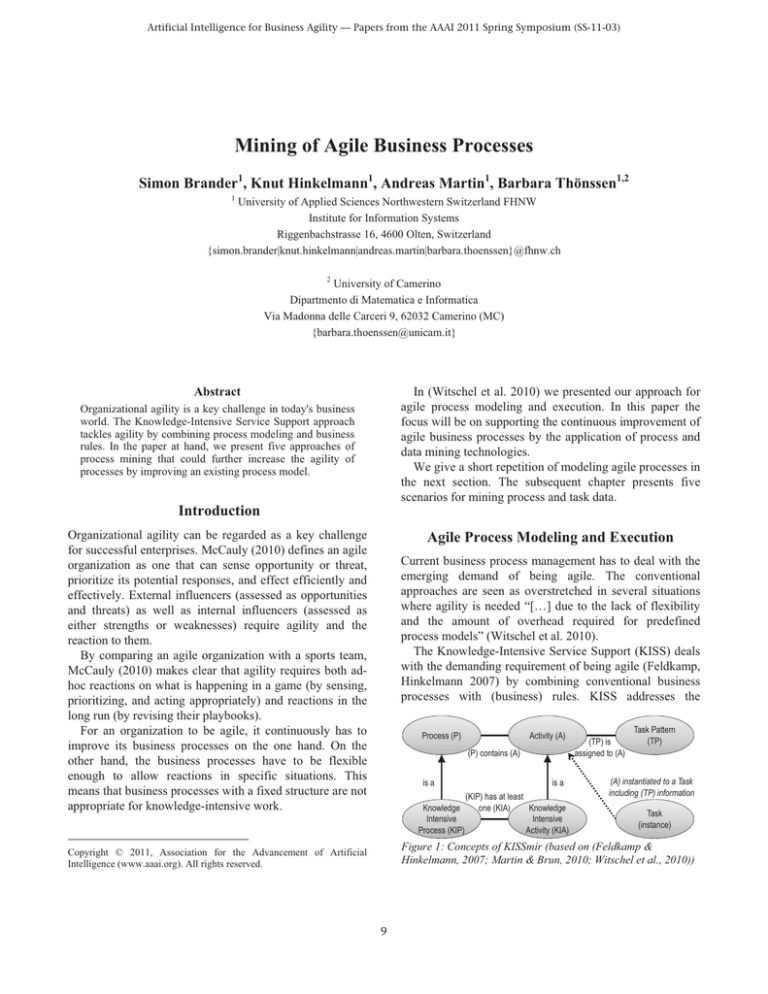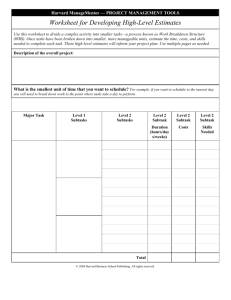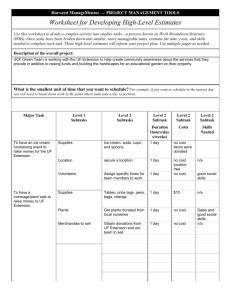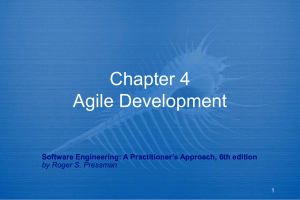
Artificial Intelligence for Business Agility — Papers from the AAAI 2011 Spring Symposium (SS-11-03)
Mining of Agile Business Processes
Simon Brander1, Knut Hinkelmann1, Andreas Martin1, Barbara Thönssen1,2
1
University of Applied Sciences Northwestern Switzerland FHNW
Institute for Information Systems
Riggenbachstrasse 16, 4600 Olten, Switzerland
{simon.brander|knut.hinkelmann|andreas.martin|barbara.thoenssen}@fhnw.ch
2
University of Camerino
Dipartmento di Matematica e Informatica
Via Madonna delle Carceri 9, 62032 Camerino (MC)
{barbara.thoenssen@unicam.it}
In (Witschel et al. 2010) we presented our approach for
agile process modeling and execution. In this paper the
focus will be on supporting the continuous improvement of
agile business processes by the application of process and
data mining technologies.
We give a short repetition of modeling agile processes in
the next section. The subsequent chapter presents five
scenarios for mining process and task data.
Abstract
Organizational agility is a key challenge in today's business
world. The Knowledge-Intensive Service Support approach
tackles agility by combining process modeling and business
rules. In the paper at hand, we present five approaches of
process mining that could further increase the agility of
processes by improving an existing process model.
Introduction
Organizational agility can be regarded as a key challenge
for successful enterprises. McCauly (2010) defines an agile
organization as one that can sense opportunity or threat,
prioritize its potential responses, and effect efficiently and
effectively. External influencers (assessed as opportunities
and threats) as well as internal influencers (assessed as
either strengths or weaknesses) require agility and the
reaction to them.
By comparing an agile organization with a sports team,
McCauly (2010) makes clear that agility requires both adhoc reactions on what is happening in a game (by sensing,
prioritizing, and acting appropriately) and reactions in the
long run (by revising their playbooks).
For an organization to be agile, it continuously has to
improve its business processes on the one hand. On the
other hand, the business processes have to be flexible
enough to allow reactions in specific situations. This
means that business processes with a fixed structure are not
appropriate for knowledge-intensive work.
Agile Process Modeling and Execution
Current business process management has to deal with the
emerging demand of being agile. The conventional
approaches are seen as overstretched in several situations
where agility is needed “[…] due to the lack of flexibility
and the amount of overhead required for predefined
process models” (Witschel et al. 2010).
The Knowledge-Intensive Service Support (KISS) deals
with the demanding requirement of being agile (Feldkamp,
Hinkelmann 2007) by combining conventional business
processes with (business) rules. KISS addresses the
Process (P)
Activity (A)
(P) contains (A)
is a
is a
(KIP) has at least
one (KIA)
Knowledge
Knowledge
Intensive
Intensive
Process (KIP)
Activity (KIA)
(TP) is
assigned to (A)
Task Pattern
(TP)
(A) instantiated to a Task
including (TP) information
Task
(instance)
Figure 1: Concepts of KISSmir (based on (Feldkamp &
Hinkelmann, 2007; Martin & Brun, 2010; Witschel et al., 2010))
Copyright © 2011, Association for the Advancement of Artificial
Intelligence (www.aaai.org). All rights reserved.
9
common problems of dynamic or agile processes, such as
exceptional situations, unforeseeable events, unpredictable
situations, high variability, or highly complex tasks
(Feldkamp, Hinkelmann 2007).
The “collaborative approach to maturing of processrelated knowledge” introduced by Witschel et al. (2010)
combines the knowledge intensive processes (KIP) of
KISS with task patterns. Figure 1 illustrates the following
definitions. “A knowledge intensive process (KIP) can be
regarded as a collection of activities building the 'skeleton'
of a business process, some activities of which can be
knowledge intensive (called 'KIA')” (Witschel et al. 2010).
Modeling knowledge-intensive processes corresponds to
ad-hoc processes of BPMN where the process flow is not
modeled in detail but activities can be executed in any
order and any frequency (White & Miers 2008). “Whereas
ordinary activities are always executed (i.e., in every
process [instance]), KIAs are optionally executed
depending on information specific for the certain process
instance” (Witschel et al. 2010). This information can for
example be application data, process data, functional data,
or further information about needed resources. KISS
supports the execution of knowledge-intensive processes
by planning components and business rules (Feldkamp,
Hinkelmann 2007).
Instances of activities are called tasks as described in
Witschel et al. (2010) and it does not matter if the activity
is knowledge-intensive or not. “A task is a definition of a
particular item of work that specifies the requirements and
the goal of this work” (Witschel et al. 2010). A task pattern
is like a template of a task that contains all relevant
information and experience for the task execution.
Examples are information about resources that can be used,
sub-tasks that should be performed or problem / solution
information, which enable users to share their experience
(Riss, Rickayzen, Maus, van der Aalst 2005). According to
Witschel et al. (2010) it can be seen as a “[…] mediator
between process modeling and individual task execution”.
To point that out, we have a one-to-one relationship
between an activity of an agile business process and a task
pattern in the introduced approach.
The KISSmir system (Martin, Brun 2010), developed
during the EU-funded project MATURE, is a process
handling and information sharing tool and implements the
principles of knowledge-intensive processes and tasks /
task patterns (Witschel et al. 2010). “It focuses on the
modeling of knowledge intensive business processes and
aims at the following goal: The individual knowledge and
experience used when carrying out a process should be
shared with other employees in an organization” (Martin,
Brun 2010). This can be seen in Figure 2. The heart in the
KISSmir system is the execution of a (knowledgeintensive) process. A task pattern that contains taskspecific information (e.g. general task information, shared
resources, recommended subtasks, shared experience) is
assigned to each activity. If the activity should be
performed, it is instantiated to a task using the task pattern.
The task contains task-specific resources provided by the
process or the user, subtasks or personal experience etc.
The user or assignee of the task has the possibility to add
additional information to the task. If he does so, he is asked
if he wants to share this information by publishing or
adding it to the task pattern. KISSmir also gives the user
the possibility to access or retrieve historical cases that are
similar to the one at hand. The mining approaches of agile
business processes (shown in the next section) rely on the
described KISSmir system.
Mining of Agile Process Data
KISS and KISSmir support one aspect of agility - the
flexible reaction on specific situations. In this section we
deal with the second aspect of agility - the continuous
adaption of business processes in a dynamic environment.
This is achieved by applying process mining in order to
suggest potential process improvements.
Van der Aalst and Weijters (2004) use the term process
mining “for the method of distilling a structured process
description from a set of real executions”. According to
Van der Aalst et al (2007), one can further distinguish
three perspectives in process mining. The process
perspective concerns “the ordering of activities”, which is
represented by the control flow. The organizational
perspective focuses on the involved people and their
relations. The case perspective covers case properties, such
as the execution path or instance-specific values.
We illustrate the mining approaches by using the
admission process for a Master Program at the University
of Applied Sciences Northwestern Switzerland as an
example. The process is illustrated in Figure 3. Each
rectangle represents an activity (e.g. “Check
KISSmir system
…
KIA
Task pattern (TP)
[in repository]
• Shared resources
• Recommended sub- tasks
• Shared experience
consuming /
retrieve
...
publish / share
Task (instance)
[on task management system]
Task pattern
information
…
Historical cases
[in repository]
Historical case
information
retrieve
Knowledge
intensive process
(KIP) [on BP
system]
KIA
…
• Task-specific resources
• Performed sub- tasks
• Personal experience
Figure 2: The KISSmir system (based on (Martin & Brun, 2010;
Witschel et al., 2010))
10
Calculate Study Fees
R1
Hans Muster
BSc Hon BIS
01-8852-84
Hans Muster
BSc Hon BIS
01-8852-84
Hans Muster
BSc Hon BIS
01-8852-84
R3
R4
Check
Completeness
R3
R4
Record Application
in Inf. System
Secretary
Secretary
...
Secretary
yes
R3
R4
R4
Check Certification
(KIA)
Secretary
Certificate
accepted and
sufficient?
no
Send Rejection
Letter
...
Secretary
Secretary
R1
R2
R3
R4
R2
R2
R3
R4
R2
R2
Kasimir Log:
CA.CB.CD // CA.CB.CC // CA.CD //
CA.CB.CC.CD // CA.CB.CC // CA.CB.CD
CA
CD
not sure
Check Certification
(KIA)
...
Dean of Study Affairs
R1
CC
CB
R2
R3
R3
R4 R3
R4
R3
CA
CB
?
Check
Documents
CC
no
R3
CD
EU?
yes
Req. Cert.
Translation
Create
Dossier
Figure 3: Section of the matriculation process at the School of Business (FHNW)
Completeness”) and the responsible role (e.g. “Secretary”).
The tables connected to an activity represent a task. The Ri
in the tables represent resources suggested by the KISSmir
system and also resources actually used by the participant
during execution. Examples of such resources are
documents, websites, or people.
In the following we show five process mining
approaches. These approaches are innovative because they
utilize the process agility as well as the used resources
attached to tasks and task patterns.
In a nutshell, the Subtask Discovery, Determine Subtask
Execution Order, and Resource-Based Task Refinement
approaches cover the process perspective, while the case
perspective is part of the Resource Recommendation and
Retrospective Resource Recommendation approaches. The
organizational perspective is not directly addressed.
resources depending on the concrete case. One reason for
this is that people executing the task can have different
experiences and skills. Another cause is the fact that each
case is (at least to some extent) unique. Therefore, there is
only a small chance that one set of resources covers all
cases.
The KISSmir system stores all executions of a given
task. Based on the case data (the independent variables) the
process miner attempts to discover potentially useful
resources (the dependent variable). Once such sets of case
Resource Recommendation
The first process mining approach deals with the case
perspective. When someone works on an assigned task,
she/he can add resources to the task instance. When
executing a task, different participants might use different
Figure 4: Additional resources based on historical case analysis
11
data and resources are found, the system makes use of
them by suggesting potentially useful resources in future
executions of the task.
Assume that in the “Check Certification” activity of or
sample process, a participant found a website listing all the
accepted university programs of some foreign countries.
He adds this website to the task description. If in future a
case of an applicant from one of these countries is to be
dealt with, the system can automatically suggest the
website thus raising awareness by the users that did not
know of this resource.
Resource-Based Task Refinement
The resource-based task refinement can be associated with
the process perspective. As the previous suggestion, the
resource-based task refinement also uses the fact that
different resources are used to complete a task. The goal of
this approach is to refine the existing process model. This
is achieved by using the stored information about
executions of a given task.
In the analysis phase, patterns of used resources are
discovered. In the following refinement phase, it is
assumed that one pattern of used resources equals a
particular task. Different patterns of used resources for one
task indicate a potential opportunity to refine the process
model. This is done in the refinement phase: It consists of
making sense of the found patterns. In order to determine
whether a model refinement is appropriate, variables that
could define whether an identified pattern applies to the
case are presented to a human expert. The expert also takes
a closer look at the resources (e.g. the contents of a text
document) in a resource pattern to make more sense of the
patterns and the respective triggers. This ensures that
dependencies are discovered even if the system were not
initially able to find them. The final step is the process
refinement phase, in which the identified process model
adaption is implemented. Resource patterns are reflected in
adjusted or additional tasks, and gateways represent
identified triggers.
If a candidate obtained her Bachelor’s degree from a
university outside of the European Union, the secretary
might, for example, use a specific website of the Swiss
government to check whether she needs to provide
additional documents, such as a certified English
attestation that states the equivalence of the degree in the
Bologna system. A consequence of analyzing the used
resources might be that the task “Check Completeness” (of
an application) can be concretized into a gateway element
with a root for holders of European diplomas and a second
root for all other holders with the additional task “Request
Certified Translation“.
Retrospective Resource Recommendation
When decisions about applications have to be made, we
often find the following three types of cases: There are
obvious cases that can immediately be rejected or accepted
by a clerk or assistant. However, there is a third group of
cases that require detailed investigation by an expert. This
investigation is expensive and thus it should be avoided.
The mining approach for learning decision criteria
analyses the results of the detailed investigation trying to
identify the decision criteria or at least finding those
resources the expert used to support his decision making.
If in future similar cases the clerk is made aware of this
resource, a detailed investigation by the expert could be
avoided.
Retrospective resource recommendation is quite similar
to the resource recommendation as described in the
previous subsection. Again, the use of resources is
analyzed to suggest potential resources in future cases.
However, the recommendations are not attached to the task
in which the resources was used but to a previous task.
In the example process, a secretary might not be sure
whether a certificate can be accepted or not. The dean of
the appropriate study program then has to decide whether
the degree satisfies the program requirements or not. The
dean might use resources that the secretary is not aware of
to come to a decision. This could, for example, be a
document on the network drive that contains a list of
universities in a country and the various earlier decisions.
If the secretary can decide future cases by himself using
this list, the expensive involvement of the expert – in the
given case the dean – can be reduced.
Figure 5: Resources used by experts recommended at earlier
stage to normal performers
Figure 6: Task refinement based on use of resources
12
Subtask Discovery
Kasimir Log:
CA.CB.CD // CA.CB.CC //
CA.CD // CA.CB.CC.CD //
CA.CB.CC // CA.CB.CD //
CA.CD // CB.CA.CD // ...
When executing knowledge-intensive activities, it may
happen that a participant delegates parts of the task to a
colleague. If this happens in a number of cases, this might
be an indicator that the process model is not detailed
enough and the knowledge-intensive task could be divided
into several subtasks.
We assume that a participant executing a task records
the delegation in the task description. The subtask
discovery approach analyses records of previous task
executions to identify in which situations a task delegation
happened. The criteria can be included as a decision point
into the process model. By identifying subtasks, a
knowledge-intensive activity gets more structured and
evolves towards a knowledge-intensive process.
In the sample process this can happen if in order to
validate the qualification a reference persons is contacted.
This activity can be added as a subtask.
Figure 8: Process fragment discovery based on analysis of
previous cases
Conclusion
The introduced approach aims for bridging the gap
between process modeling (design time) and process
execution (run time). Most process models base on indepth business process analysis, representing possible
requirements and constraints at a certain point of time as
close as possible. After that, the model is transferred into
an executable version, deployed and used. Even though a
process model has been well defined, business changes
quickly and the model might be already outdated when it is
executed for the first time. If this is the case, users start
creating workarounds to cope with the changes. In general,
those 'deviations' are not captured, analyzed or mined for
process improvements. Only when processes are to be
improved and the management cycle starts again, models
are adapted. With our approach, actions that users take
during process execution are audited continuously and,
therefore, suggestions for improvements can be derived at
any time without additional effort and according to actual
needs. Beside that, process optimization is achieved for
knowledge-intensive processes and activities. Mining
instances of these parts allow for constantly improving
suggestions of resources, tasks or sequences of activities.
An extension of our mining approaches would be to
identifying workflow resource patterns as introduced by
Russell et al. (2004). This would require that we record the
use of resources in more detail.
Potential Subtasks:
CA
CD
CC
CB
Figure 7: Subtask discovery based on previous subtasks
Determine Subtask Execution Order
As described above, the KISS part of KISSmir allows to
model knowledge-intensive processes where the order of
activities is not defined and each activity can be executed
several times.
The Determine Subtask Execution Order analyses the
actual execution order of subtasks in a knowledgeintensive process. If the same order of subtasks is found in
many instances, the creation of a more detailed structure of
the process model can be suggested. Case variables are
used to explain and combine deviations in a similar process
model artifact. If the record also contains details about the
delegation of subtasks to other performers or roles, it can
also be suggested for future implementations of the task in
the new process model.
The combination of the subtask discovery and the
determination of subtask execution order corresponds to
what is also known as (business) process discovery, which
for example Cook and Wolf (1998) define as “methods for
automatically deriving a formal model of a process from
basic event data collected on the process”.
Acknowledgement
This work has been funded by the European Commission,
Unit for Technology-Enhanced Learning (TEL) under the
7th Framework Programme, Contract no. 216356.
References
Cook, J. E.; and Wolf, A. L. 1998. Discovering Models of
Software Processes from Event-Based Data. ACM Transactions
on Software Engineering and Methodology, 7(3), 215-249.
Feldkamp, D.; and Hinkelmann, K. 2007. KISS–KnowledgeIntensive Service Support: An Approach for Agile Process
13
Management. Advances in Rule Interchange. Retrieved from
http://www.springerlink.com/index/47848h00418l7171.pdf
Martin, A.; and Brun, R. 2010. Agile Process Execution with
KISSmir. 5th International Workshop on Semantic Business
Process Management collocated with 7th Extended Semantic Web
Conference. Heraklion, Greece.
McCauly, D. 2010. Achieving Agility. In: Swensson, Keith, D.
Mastering the Unpredictable. Tampa, Florida: Meghan-Kiffer
Press.
Riss, U. V.; Rickayzen, A.; Maus, H.; and van der Aalst, W. M.
P. 2005. Challenges for business process and task management.
Journal of Universal Knowledge Management, 0(2), 77-100.
Russell, N.; ter Hofstede, A.H.M.; Edmond, D.; and van der
Aalst, W.M.P. 2004. BETA Working Paper Series, WP 127,
Eindhoven University of Technology, Eindhoven, 2004.
Van der Aalst, W. M. P.; Reijers, H.; Weijters, A.; Van Dongen,
B.; Alves De Medeiros, A.; Song, M.; and Verbeek, H.M.V.
2007. Business process mining: An industrial application,
Information Systems, 32 (5), 713-732.
Van der Aalst, W. M. P.; and Weijters, A. J. M. M. 2004. Process
mining: a research agenda, Computers in Industry, 53 (3), 231244.
White, S.A.; and Miers, D. 2008. BPMN - Modeling and
Reference Guide. Future Strategies Inc.
Witschel, H.-F.; Hu, B.; Riss, U. V.; Thönssen, B.; Brun, R.;
Martin, A.; and Hinkelmann, K. 2010. A collaborative approach
to maturing process-related knowledge. In Proceedings of the 8th
International Conference on Business Process Management. New
York, USA: Springer.
14








